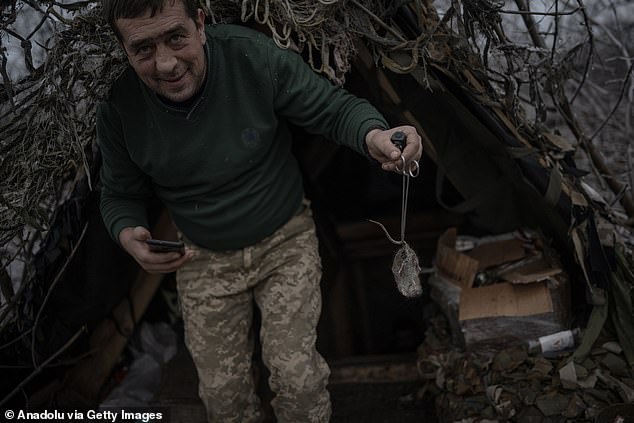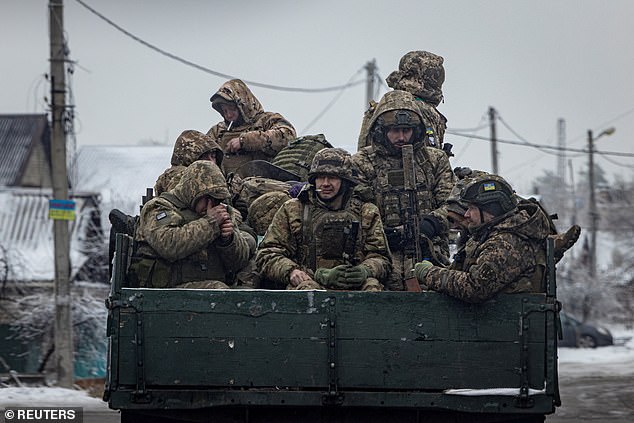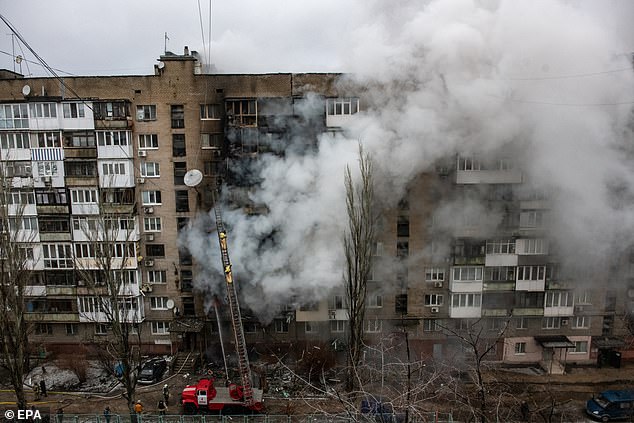'Mouse fever outbreak' mows down Russian troops on the front lines, with symptoms ranging from vomiting to bleeding eyes'
An outbreak of 'mouse fever' is 'mowing down Russia's frontline troops', Ukraine claims, with symptoms ranging from 'vomiting and bleeding eyes'.
Ukraine's Main Intelligence Directorate (HUR) reported on the outbreak of the disease among Russian units in Kupyansk, a city in the east of the country.
Russian soldiers there are said to be struggling with a lack of winter supplies as troops prepare for a second Christmas in the fight against Vladimir Putin's war.
Ukraine said the disease is a type of streptococcal infection that is transmitted to humans through direct contact with rodents or by inhaling their feces.
'In the Koupjansk direction of the front, the occupiers are being mowed down en masse by 'mouse fever', according to the update on the Telegram messaging app.
An outbreak of 'mouse fever' is 'mowing down Russia's frontline troops', Ukraine claims, with symptoms ranging from 'vomiting and bleeding eyes'. Pictured: A Ukrainian military health worker holds up a mouse with scissors in a trench, December 16
'As a result, mouse fever significantly reduced the fighting ability of Russian rats.'
Ukraine said so-called “mouse fever” can cause “severe headache, body temperature reaching 40 degrees, rash and redness, lowered blood pressure, bleeding in the eyes, nausea and vomiting several times a day.”
It added: 'Because the disease affects the kidneys, a person infected with mouse fever experiences intense pain in the lower back and has severe problems urinating.'
Ukrainian HUR claimed that the suffering of Russian soldiers fell on deaf ears, with commanders using their complaints as an excuse to avoid fighting.
“Complaints about fever from personnel of the Russian army, involved in the war against Ukraine, were ignored by the command, considering them as a new manifestation of evading participation in combat operations,” the post said.
'Moreover, 'mouse fever' resembles normal flu in the first phase of the course.'
Although 'mouse fever' does not appear to be a clinical term, the symptoms mentioned were similar to leptospirosis, also known as rat-bite fever, although it was not immediately clear whether this is exactly the same disease that Ukraine is referring to.
Leptospirosis is also spread through contact with rodents.

Ukraine's Main Intelligence Directorate (HUR) reported on the outbreak of the disease among Russian units in Kupyansk, a city in the east of the country

A crew member of the 122mm self-propelled howitzer 2S1 Gvozdika prepares the howitzer for firing on Russian positions near the occupied Ukrainian city of Bakhmut on December 18
The claim comes near the end of a grueling year in Ukraine in which Kiev's counteroffensive fell short of expectations, emboldening Putin.
The war is now virtually at a stalemate along hundreds of miles of front lines, with the two sides separated by snow, trenches and deadly minefields.
Many soldiers are holed up in frozen trenches, under constant threat of artillery and drone attacks.
Ukrainian soldiers have complained in the past about rats and mice in the trenches, with their Russian enemies believed to be experiencing the same problems.
Photos of rats “the size of a Kalashnikov assault rifle” have been shared on social media, Tyler Kustra, assistant professor of politics and international relations at the University of Nottingham, told EuroNews.
The Russian armed forces “are dealing with a serious rodent infestation, as mice and rats seek warmth and food by entering their trenches,” he said.
“Given that the Ukrainians are just on the other side of the front line, I fear Putin is not the only pest they will have to deal with.”
Both sides have suffered heavy losses, and there are concerns that the momentum could shift in Russia's favor as winter begins to thaw next year – unless Ukraine can secure much-needed financing from its Western allies.

Ukrainian soldiers have complained in the past about rats and mice in the trenches, with their Russian enemies believed to be facing the same problems
Meanwhile, Ukraine said on Wednesday that nine people, including four children, were injured by Russian shelling in the southern city of Kherson, while drones also targeted the capital Kiev and second-largest city Kharkiv.
“During the evening shelling of Kherson by the Russian occupying forces, nine people were injured, including four children,” said Roman Mrochko, head of Kherson, adding that the children were between two and 13 years old.
A mother and her three children were hospitalized, but their condition is moderate. They have bruises and… explosive injuries,” Mrochko said on Telegram.
According to the head of the capital's military government, Serhii Popko, several Iranian-made Shahed drones were also shot down by Ukrainian air defenses while en route to Kiev.
According to the preliminary data of the operational summary, there were no casualties or destruction in the capital,” he wrote on Telegram, adding that the attack, the fifth on Kiev in December, took place from the Black Sea.
Kharkiv Mayor Igor Terekhov reported at least two strikes near residential buildings in his city. Ukraine's air force said Kharkiv was hit by “two S-300 guided anti-aircraft missiles” fired from Russia's Belgorod region.

Firefighters work at the site of a damaged building after the shelling in Donetsk
No casualties have been reported so far.
It was also said that a total of 19 Shahed launches were recorded, of which 18 were destroyed in the Odesa, Kherson, Dnipropetrovsk, Vinnytsia, Khmelnytskyi, Kiev, Chernigiv and Kirovograd regions.
Moscow has stepped up its nightly attacks on Ukrainian cities in recent weeks, at a time when the West's willingness to support the country appears to be waning.
Analysts believe Moscow's forces will target infrastructure to reduce Ukraine's ability to withstand a renewed Russian attack on the country next year.
